Managing AD, Exchange and O365 with multiple tools is tedious
One of the key features of Adaxes is the Web Interface for Active Directory management. It enables users to execute their everyday tasks, like creating new accounts, resetting passwords, modifying AD objects and performing other management and administrative activities via a standard web browser. The Web Interface also acts as a centralised control point for multiple Active Directory domains as well as Exchange and Office 365, which eliminates the need to constantly switch between multiple tools in day-to-day routines.
Practically anything about Adaxes Web Interface is customisable. You can configure it according to the requirements of different users, which then allows you to provide them with separate Web Interfaces specifically tuned for their needs. Out of the box Adaxes comes with three pre-configured Web Interfaces: Administrator, Help Desk and Self-Service.
Active Directory Administration
Administrators can make good use of the Web Interface, as it allows them to perform all their day-to-day activities via a comprehensive and convenient UI. For example, they can create new user and computer accounts, manage group memberships, modify properties of AD objects, assign and revoke Office 365 licences, etc. Admins can also execute various bulk operations via the Web Interface, like adding multiple users to groups or resetting multiple passwords in one go, even if the users are located in different domains or forests.
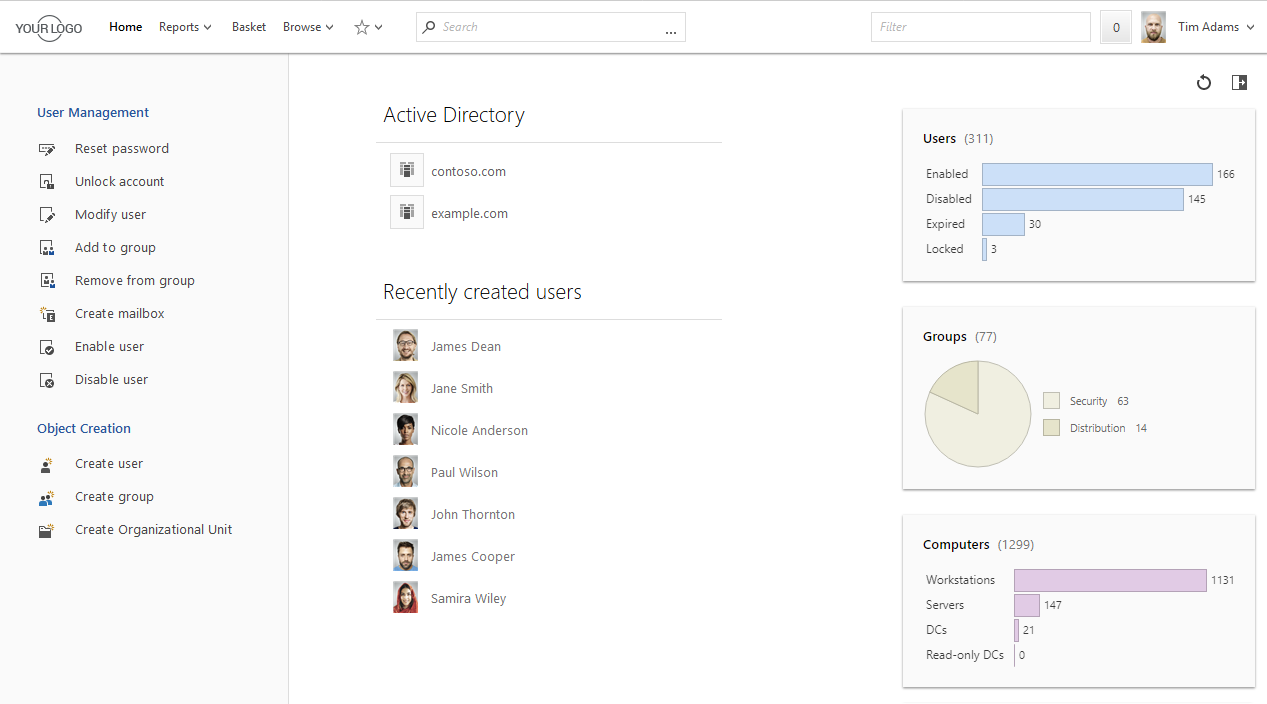
In addition to that, Adaxes provides detailed reports that allow administrators to monitor and analyse what's going on in the Active Directory environment. For example, they can view soon-to-expire accounts, users that are locked out, empty AD groups and much more.
Delegation
Although the Web Interface is a great fit for administrators, it's not just another tool solely for the IT staff. It works equally well for delegating practically any Active Directory related tasks, even to users that don't have a lot of IT skills. With Adaxes you can provide them with a simple user-friendly UI with only the views, forms and operations that are essential for their work and don't leave any room for making mistakes.
Delegating Tasks to Help Desk
Using the Web Interface, help desk technicians can do things like resetting passwords, unlocking accounts, enabling and disabling users, etc. You can also customise the operations they execute. For example, when resetting passwords, you can force the User must change password at next logon account option to be enabled and disallow to change it.
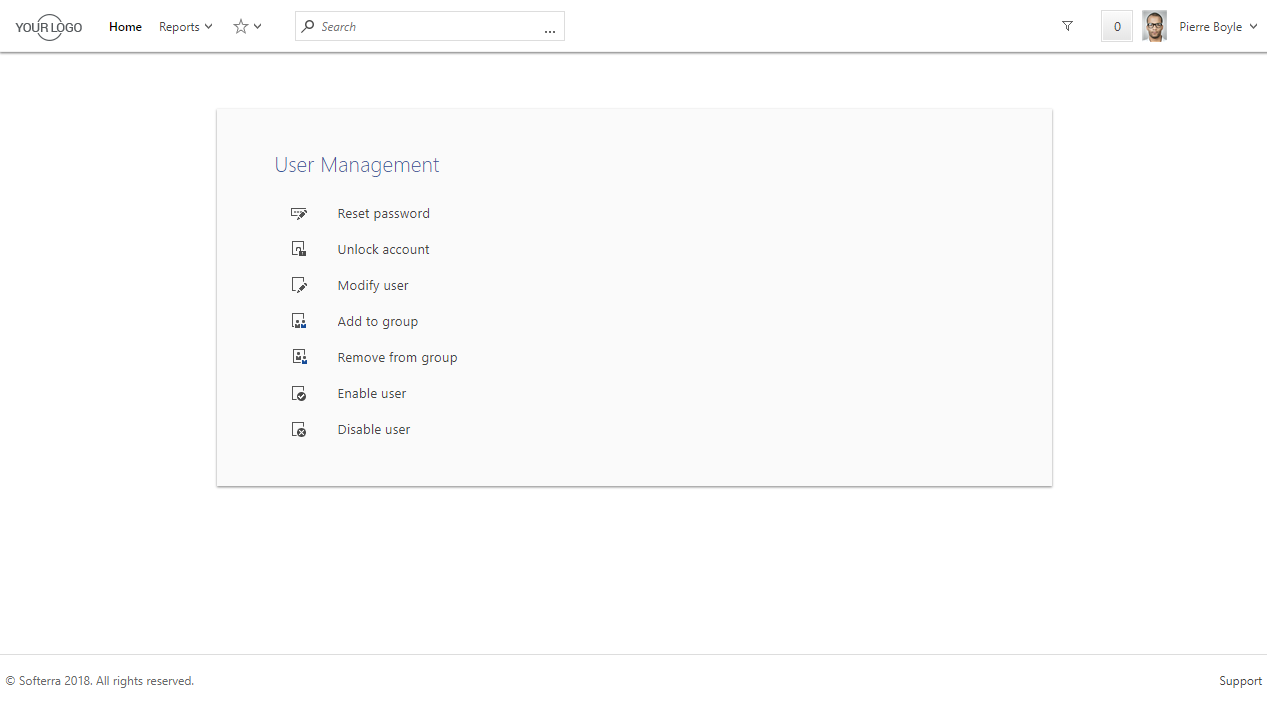
If you want to delegate more duties to your help desk staff, you can just add the respective operations to their Web Interface. For example, you can allow them to also manage computer accounts or set automatic out-of-office replies in Exchange.
Self-Service
The Web Interface can also be used by regular users for self-service purposes. You can allow them to change their phone numbers and home addresses to keep their accounts up-to-date, change own passwords, manage their distribution lists membership, update profile pictures, etc.
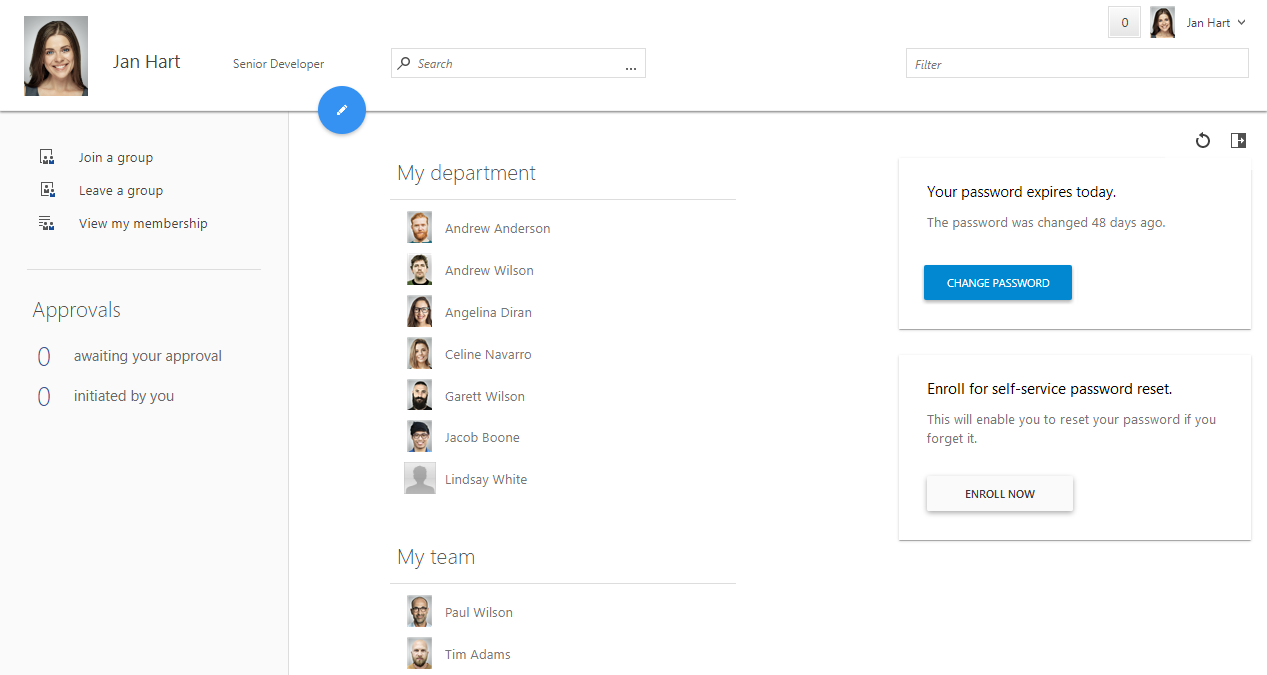
The Self-Service Web Interface can also be used as a company directory, where users can find their co-workers and view their profiles.
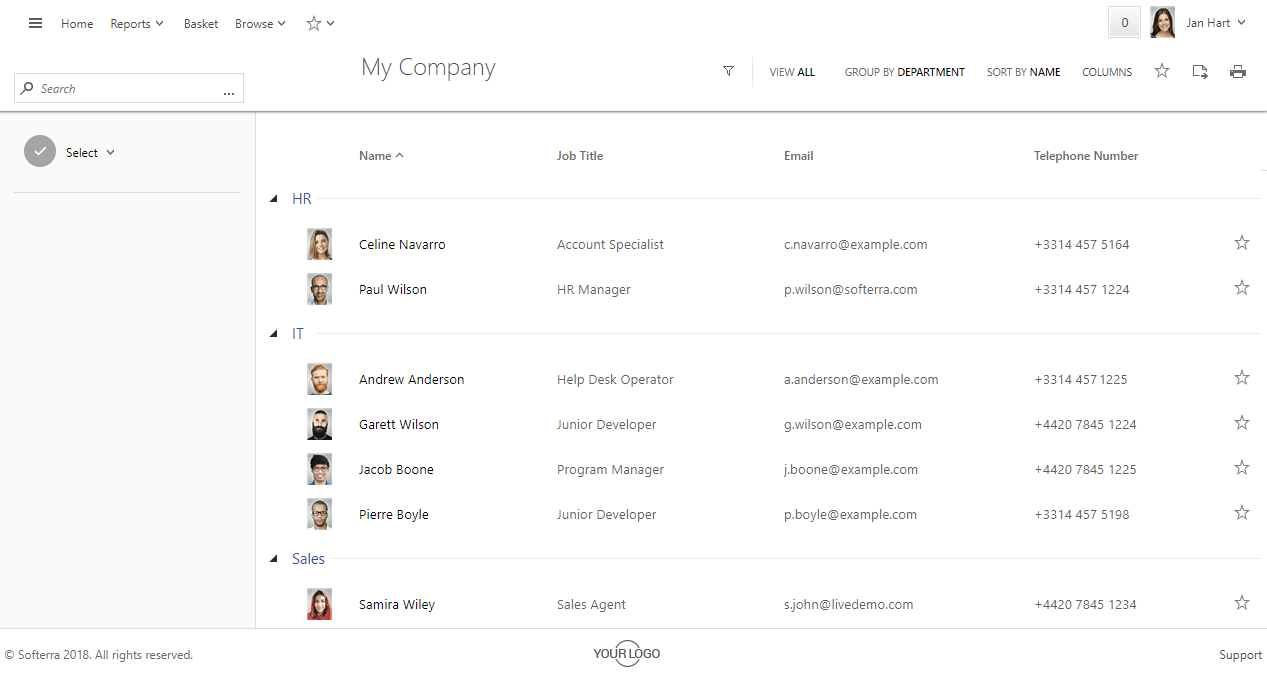
Custom Web Interfaces
In addition to the built-in Web Interfaces, Adaxes allows you to create any number of your own custom ones. You can have separate Web Interfaces for managers, auditors, HR Managers and any other category of users.
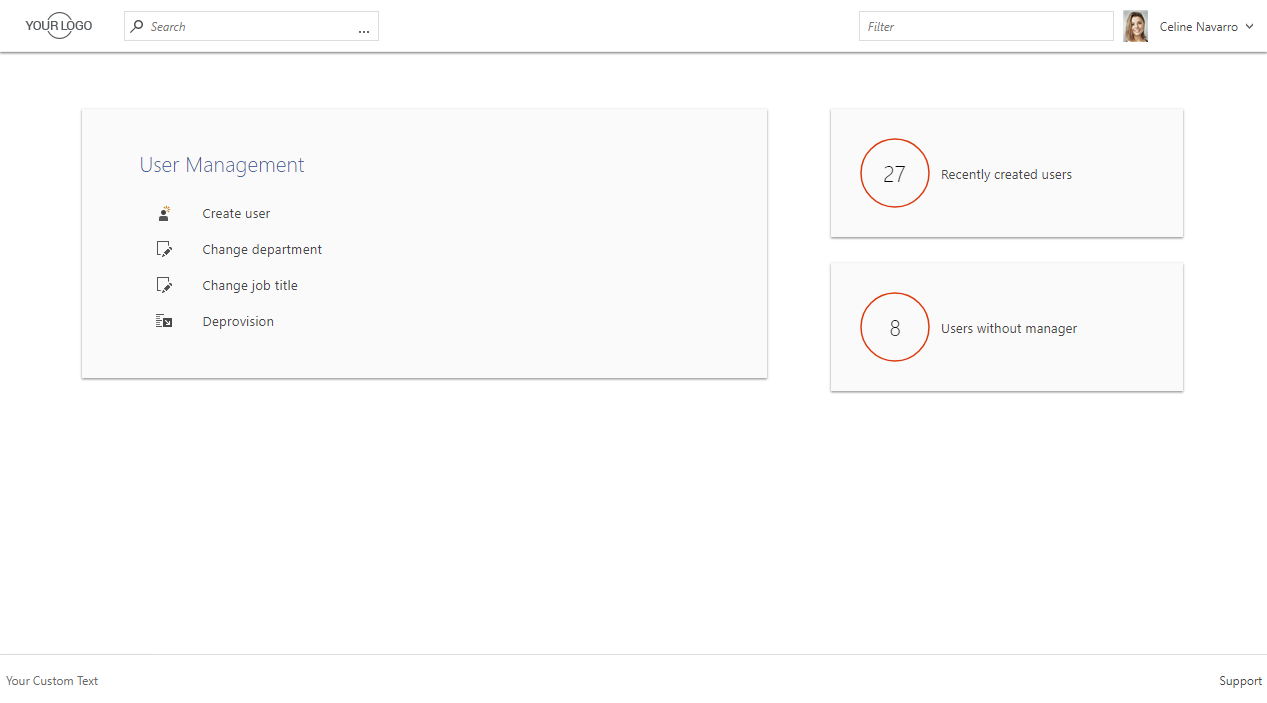
For example, a Web Interface for HR staff can only allow creating new user accounts in Active Directory via a custom form, updating fields like Job Title and Department for existing users and deprovisioning terminated employees.
Single Sign-On
By using SAML authentication you can integrate Adaxes with your corporate identity provider to enable single sign-on for the Web Interface. This way users will be able to sign in with the same authentication mechanisms they use within the rest of your organisation without the need to provide credentials every time they access the Web Interface.

Adaxes can communicate with any identity provider that supports the SAML 2.0 protocol, including Okta, OneLogin, Auth0, Azure AD, Duo, ADFS and others.
Responsive Design
Once you've given out the Web Interface to users, they can then access it from any of their devices, including phones and tablets, thanks to the responsive design.
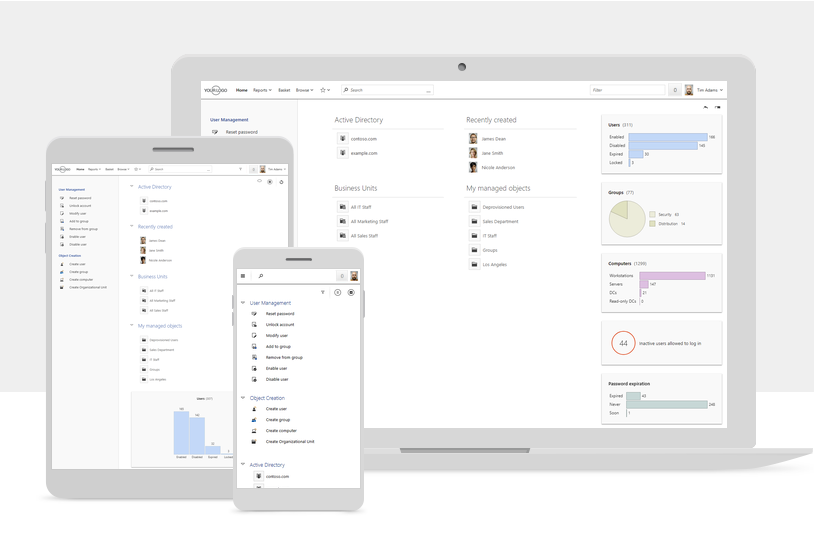
Customisation
When customising the Web Interface, you can modify its appearance by changing the colours to match your corporate design language, putting in your own logo and setting a custom favicon. This way you can tailor it to look like your own portal that belongs to your organisation.
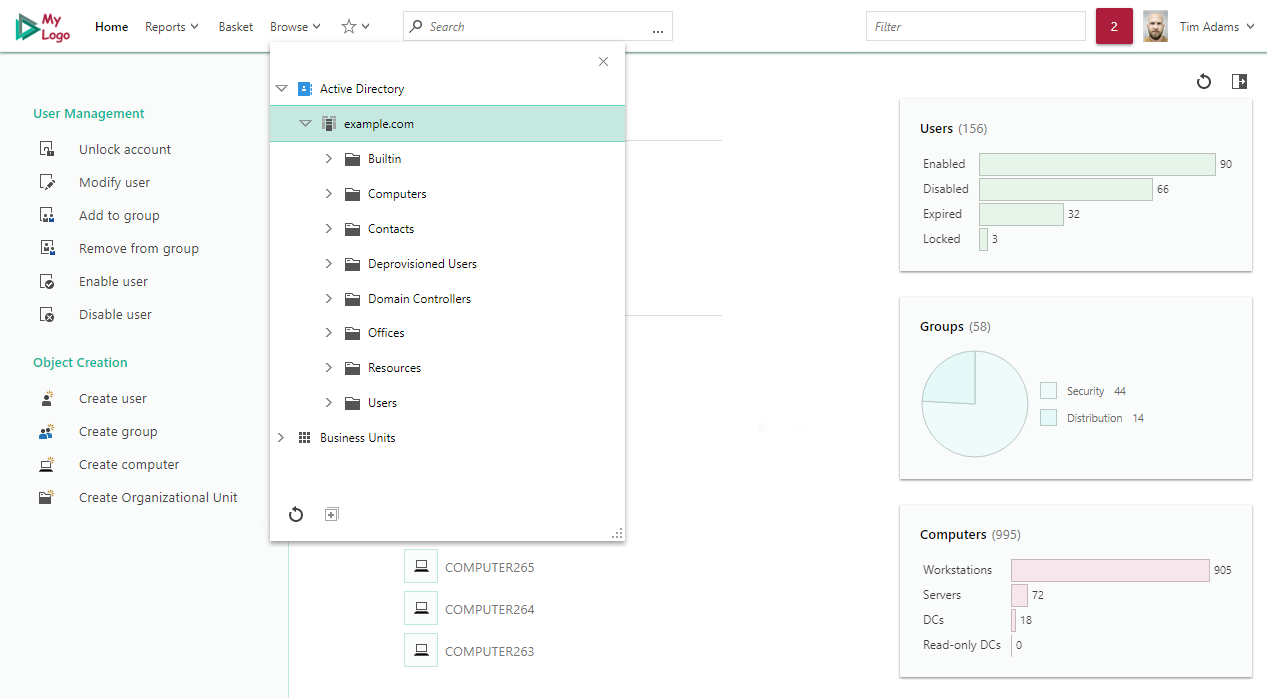
You can switch on and off entire components of the Web Interface, control which actions are available to users, limit which parts of Active Directory they can access, transform the home page, customise object creation and editing forms, etc.
Other Features
Active Directory Management
Adaxes features a rule-based platform for Active Directory, Exchange and Office 365 automation, provides an enhanced web-based management environment, gives you a role-based access control model for delegating privileges, adds security with approval-based workflow, allows enforcing corporate data standards and much more.
More InfoActive Directory Automation
Adaxes provides rule-based automation for Active Directory, Exchange and Office 365. It allows executing sets of operations that are governed by if/else conditions before or after certain events in AD. So, for example, after the department of a user is changed, Adaxes can then automatically update the user’s group membership and send an email notification to the user’s manager, following the rules you define.
More InfoActive Directory Provisioning
Using condition-based rules you can automate the entire user provisioning process. Once a new user account is created in Active Directory, Adaxes will automatically execute the rest of onboarding procedures for you: moving the user account to a correct OU, adding it to necessary groups, creating and configuring an Exchange mailbox, assigning Office 365 licences, enabling the user for Skype for Business, creating and sharing a home folder, sending a welcome email, etc. Similarly to that, you can also automate all operations associated with user updates. Finally, when a user is terminated, Adaxes can automatically execute all the provisioning operations in reverse, ensuring instant and errorless offboarding.
More InfoWeb Interface for Active Directory
Adaxes Web Interface enables Active Directory management via a standard web browser. It features a modern responsive design, so users can access it on their laptops, tablets, phones or any other devices. You can set up different Web Interfaces specifically tuned for the needs of different job roles, like administrators, help desk, HR, managers, and others, giving them a clean and intuitive way to access the tasks they need. Adaxes Web Interface also incorporates Exchange and Office 365 management, so users get a single console without the need to learn and use multiple tools for their day-to-day routines.
More InfoWeb Interface Customisation
The Adaxes Web Interface is fully customisable, so you can configure it to have the exact views, forms, and operations that each user needs. For example, administrators can have a full set of management activities in Active Directory, Exchange and Office 365 across the entire environment, whereas managers can be set to view just their subordinates and only be able to update their group membership, assign Office 365 licences and change certain AD properties.
More InfoActive Directory Self Service
Adaxes Web Interface can act as a self-service portal for regular users. You can granularly specify, which operations they have access to, like updating their personal info, changing their own password, searching Active Directory, managing own group membership, updating Office 365 licences, etc.
More InfoActive Directory Password Self-Service
Adaxes Password Self-Service allows users to reset forgotten passwords and unlock accounts by themselves. To do that they need to go through a simple identity verification procedure that may involve answering security questions, SMS verification, using authenticator apps like Google Authenticator, Authy and others. A self-password reset can be accessed from the Windows logon screen, Adaxes Web Interface or it can be integrated into your own portal.
More InfoExchange Management and Automation
Adaxes automates Exchange mailbox management both on-premises and in Office 365. For example, after creating a new user account in Active Directory, Adaxes can automatically create an Exchange mailbox for the user. The database distribution of mailboxes can be done based on the first letter of the users’ surname, least number of mailboxes in the DB, the round-robin method, etc. Adaxes can then configure the mailbox, e.g. modify storage quotas or enable mailbox features like Unified Messaging or Archiving.
More InfoOffice 365 Automation and management
Adaxes can automatically assign and revoke Office 365 licences using condition-based rules. For example, when a new user is created in Active Directory, Adaxes can activate an account in Office 365 for the user and assign the necessary O365 licences according to the rules you define. Different licences can be assigned to different users based on their job title, department, location, etc.
More InfoActive Directory Role-Based Security
Adaxes introduces Role-Based Access Control for Active Directory, Exchange and Office 365. In a role-based delegation model, instead of assigning permissions to users, they are assigned to roles that correspond to actual job functions. So, when you need to change privileges for all users with the same job function, all you need to do is modify the permissions of the associated role. Assigning roles to users is done in a centralised manner, allowing you to easily control, who can do what and where. With role-based delegation, you can granularly specify, which parts of Active Directory are visible to users. For example, you can allow certain users to only view AD objects located in their own OU, while hiding the rest of the Active Directory structure from them.
More InfoApproval-Based Workflow
Adaxes allows you to add an approval step to practically any operation in Active Directory, Exchange and Office 365. For example, you can delegate user creation to HR, but after they fill in the form and click Create, Adaxes can suspend the operation and only proceed once a member of IT staff reviews and approves it. For more complex and security-sensitive scenarios, you can set up multi-level approvals. Such an approach allows delegating more tasks to lower level staff without taking the risk of losing control over them.
More InfoActive Directory Reports
Adaxes comes with reporting capabilities, allowing you to monitor and analyse what’s going on in your environment. Out of the box, you get more than 200 reports, which should cover the majority of your requirements. For more demanding scenarios Adaxes also provides various ways to create custom reports, including using your own scripts. It enables you to create reports of practically any complexity that can be specific to your organisation's needs. To deliver reports to users Adaxes supports centralised scheduling and also provides a self-scheduling option, allowing users to choose by themselves, which reports they want to receive and when.
More InfoCustom Commands for Active Directory
With Custom Commands users can launch complex multi-step operations in one go. For example, if you need to send a user on vacation, you can do it with just one click in the Web Interface. The operation can include steps like disabling the user account, adding it to a corresponding group, sending a notification to the user’s manager, etc. Such an approach allows you to delegate complicated tasks to users and not worry that they will miss a step or do something wrong. Besides, you don’t over-privilege them, as you only give out permissions to execute the Custom Command as a whole, not the individual steps it consists of. Administrators can also use Custom Commands in their day-to-day routines to make the management process simpler and accomplish the same results with a lot fewer clicks.
More InfoScheduled Tasks for Active Directory Management
Adaxes allows you to automate various routine management tasks by scheduling them. For example, it can automatically de-provision inactive accounts in AD, allocate users to necessary groups, maintain OU structure, etc. You can also schedule tasks like importing new users from CSV. Automating such a sensitive operation doesn’t mean that you need to sacrifice any control, as you can add an approval step to it. This way users will be created in AD only after a member of IT staff reviews and approves the operation. You can also use scheduled tasks to send various notifications to users, like reminders about their password or account expiration.
More InfoActive Directory Delegation
Active Directory management involves many different operations that require administrative privileges granted by default to AD administrators only. Though operations like password reset or account unlock are pretty simple, they take a lot of time of highly-skilled IT staff, not allowing them to focus on more complex and important issues. Active Directory delegation helps you optimise the productivity of the IT department by letting non-administrative users (e.g. department managers or Help Desk operators) perform certain administrative activities in Active Directory.
More Info

